Metabolic Changes in Serum and Milk of Holstein Cows in Their First to Fourth Parity Revealed by Biochemical Analysis and Untargeted Metabolomics
Abstract
Simple Summary
Abstract
1. Introduction
2. Materials and Methods
2.1. Animals and Experimental Design
2.2. Sample Collection and Analysis
2.3. Metabolomics Analysis by UPLC-MS/MS
2.4. Metabolomics Data Processing
2.5. Statistical Analysis
3. Results
3.1. Milk Quality and Hydrolyzed Amino Acids
3.2. Serum Biochemical Parameters and Free Amino Acids
3.3. Metabolomics Multivariate Analysis of Serum and Milk
3.4. Differential Metabolite Identification of Serum and Milk
3.5. Pathway Analysis of Serum and Milk
3.6. Interaction Analysis of Serum and Milk Metabolites
4. Discussion
5. Conclusions
Supplementary Materials
Author Contributions
Funding
Institutional Review Board Statement
Informed Consent Statement
Data Availability Statement
Acknowledgments
Conflicts of Interest
Abbreviations
| ADF | Acid detergent fiber |
| AOAC | Official Analytical Chemists methodologies |
| ALB | Albumin |
| BUN | Blood urea nitrogen Burea nitrogen |
| Ca | Calcium |
| CP | Crude protein |
| DIM | Days in milk |
| DM | Dry matter |
| EAA | Essential amino acid |
| GE | Gross energy |
| GLU | Glucose |
| HCA | Hierarchical cluster analysis |
| HCL | Hydrochloric acid |
| HDL-C | High-density lipoprotein cholesterol |
| KEGG | Genes and Genomes pathway database |
| LDL-C | Low-density lipoprotein cholesterol |
| LIP | Lipase |
| NDF | Neutral detergent fiber |
| NEAA | Non-essential amino acids |
| NH3L | Blood ammonia |
| OPLS-DA | Orthogonal partial least squares discriminate analysis |
| P | Phosphorus |
| RT | Retention time |
| SCC | Somatic cell count |
| SEM | Standard error of means |
| TAA | Total amino acid |
| TG | Triglyceride |
| TMR | Total mixed rations |
| TP | Total protein |
| UPLC-MS/MS | Ultra-high-resolution high-performance liquid chromatography with tandem mass spectrometry |
| VIP | Variable importance in the projection |
References
- Rodriguez-Godina, I.J.; Garcia, J.E.; Mellado, J.; Morales-Cruz, J.L.; Contreras, V.; Macias-Cruz, U.; Avendano-Reyes, L.; Mellado, M. Permanence time in the herd and milk production of holstein cows with up to five successive extended lactations. Trop. Anim. Health Prod. 2021, 53, 141. [Google Scholar] [CrossRef]
- Roca-Fernandez, A.I.; Gonzalez-Rodriguez, A.; Vazquez-Yanez, O.P. Effect of calving date and parity on milk performance of grazing dairy herds. Grassl. A Eur. Resour. 2012, 17, 270–272. [Google Scholar]
- Artegoitia, V.; Meikle, A.; Olazabal, L.; Damian, J.P.; Adrien, M.L.; Mattiauda, D.A.; Bermudez, J.; Torre, A.; Carriquiry, M. Milk casein and fatty acid fractions in early lactation are affected by nutritional regulation of body condition score at the beginning of the transition period in primiparous and multiparous cows under grazing conditions. J. Anim. Physiol. Anim. Nutr. 2013, 97, 919–932. [Google Scholar] [CrossRef]
- Vrhel, M.; Duchacek, J.; Gasparik, M.; Vacek, M.; Codl, R.; Pytlik, J. Milkability differences based on lactation peak and parity in holstein cattle. J. Anim. Feed. Sci. 2021, 30, 206–213. [Google Scholar] [CrossRef]
- Bilal, G.; Cue, R.I.; Mustafa, A.F.; Hayes, J.F. Effects of parity, age at calving and stage of lactation on fatty acid composition of milk in canadian holsteins. Can. J. Anim. Sci. 2014, 94, 401–410. [Google Scholar] [CrossRef]
- Stadnik, L.; Duchacek, J.; Okrouhla, M.; Ptacek, M.; Beran, J.; Stupka, R.; Zita, L. The effect of parity on the proportion of important healthy fatty acids in raw milk of holstein cows. Mljekarstvo 2013, 63, 195–202. [Google Scholar]
- Gross, J.J.; Bruckmaier, R.M. Review: Metabolic challenges in lactating dairy cows and their assessment via established and novel indicators in milk. Animal 2019, 13, s75–s81. [Google Scholar] [CrossRef] [PubMed]
- Alseekh, S.; Aharoni, A.; Brotman, Y.; Contrepois, K.; D’Auria, J.; Ewald, J.; Ewald, J.C.; Fraser, P.D.; Giavalisco, P.; Hall, R.D.; et al. Mass spectrometry-based metabolomics: A guide for annotation, quantification and best reporting practices. Nat. Methods 2021, 18, 747–756. [Google Scholar] [CrossRef] [PubMed]
- Goldansaz, S.A.; Guo, A.C.; Sajed, T.; Steele, M.A.; Plastow, G.S.; Wishart, D.S. Livestock metabolomics and the livestock metabolome: A systematic review. PLoS ONE 2017, 12, e0177675. [Google Scholar] [CrossRef] [PubMed]
- Sun, H.-Z.; Wang, D.-M.; Wang, B.; Wang, J.-K.; Liu, H.-Y.; Guan, L.L.; Liu, J.-X. Metabolomics of four biofluids from dairy cows: Potential biomarkers for milk production and quality. J. Proteome Res. 2015, 14, 1287–1298. [Google Scholar] [CrossRef] [PubMed]
- Serkova, N.J.; Standiford, T.J.; Stringer, K.A. The emerging field of quantitative blood metabolomics for biomarker discovery in critical illnesses. Am. J. Respir. Crit. Care Med. 2011, 184, 647–655. [Google Scholar] [CrossRef]
- Sun, H.; Wang, B.; Wang, J.; Liu, H.; Liu, J. Biomarker and pathway analyses of urine metabolomics in dairy cows when corn stover replaces alfalfa hay. J. Anim. Sci. Biotechnol. 2016, 7, 49. [Google Scholar] [CrossRef]
- Sun, H.Z.; Shi, K.; Wu, X.H.; Xue, M.Y.; Wei, Z.H.; Liu, J.X.; Liu, H.Y. Lactation-related metabolic mechanism investigated based on mammary gland metabolomics and 4 biofluids’ metabolomics relationships in dairy cows. BMC Genom. 2017, 18, 936. [Google Scholar] [CrossRef]
- Wu, X.; Sun, H.; Xue, M.; Wang, D.; Guan, L.L.; Liu, J. Serum metabolome profiling revealed potential biomarkers for milk protein yield in dairy cows. J. Proteom. 2018, 184, 54–61. [Google Scholar] [CrossRef] [PubMed]
- Xue, M.-Y.; Xie, Y.-Y.; Zhong, Y.; Ma, X.-J.; Sun, H.-Z.; Liu, J.-X. Integrated meta-omics reveals new ruminal microbial features associated with feed efficiency in dairy cattle. Microbiome 2022, 10, 32. [Google Scholar] [CrossRef] [PubMed]
- Klein, M.S.; Almstetter, M.F.; Schlamberger, G.; Nürnberger, N.; Dettmer, K.; Oefner, P.J.; Meyer, H.H.D.; Wiedemann, S.; Gronwald, W. Nuclear magnetic resonance and mass spectrometry-based milk metabolomics in dairy cows during early and late lactation. J. Dairy Sci. 2010, 93, 1539–1550. [Google Scholar] [CrossRef] [PubMed]
- Xu, W.; Vervoort, J.; Saccenti, E.; van Hoeij, R.; Kemp, B.; van Knegsel, A. Milk metabolomics data reveal the energy balance of individual dairy cows in early lactation. Sci. Rep. 2018, 8, 15828. [Google Scholar] [CrossRef]
- Humer, E.; Khol-Parisini, A.; Metzler-Zebeli, B.U.; Gruber, L.; Zebeli, Q. Alterations of the lipid metabolome in dairy cows experiencing excessive lipolysis early postpartum. PLoS ONE 2016, 11, e0158633. [Google Scholar] [CrossRef]
- Pacífico, C.; Stauder, A.; Reisinger, N.; Schwartz-Zimmermann, H.E.; Zebeli, Q. Distinct serum metabolomic signatures of multiparous and primiparous dairy cows switched from a moderate to high-grain diet during early lactation. Metabolomics 2020, 16, 96. [Google Scholar] [CrossRef]
- Van Soest, P.J.; Robertson, J.B.; Lewis, B.A. Methods for dietary fiber, neutral detergent fiber, and nonstarch poly-saccharides in relation to animal nutrition. J. Dairy Sci. 1991, 74, 3583–3597. [Google Scholar] [CrossRef]
- Bobic, T.; Mijic, P.; Gregic, M.; Gantner, V. The differences in milkability, milk, and health traits in dairy cattle due to parity. Mljekarstvo 2018, 68, 57–63. [Google Scholar] [CrossRef]
- Van, Q.C.; Knapp, E.; Hornick, J.-L.; Dufrasne, I. Influence of days in milk and parity on milk and blood fatty acid concentrations, blood metabolites and hormones in early lactation holstein cows. Animals 2020, 10, 2081. [Google Scholar] [CrossRef] [PubMed]
- Sabek, A.; Li, C.; Du, C.; Nan, L.; Ni, J.; Elgazzar, E.; Ma, Y.; Salem, A.Z.M.; Zhang, S. Effects of parity and days in milk on milk composition in correlation with β-hydroxybutyrate in tropic dairy cows. Trop. Anim. Health Prod. 2021, 53, 270. [Google Scholar] [CrossRef] [PubMed]
- Du, C.; Nan, L.; Yan, L.; Bu, Q.; Ren, X.; Zhang, Z.; Sabek, A.; Zhang, S. Genetic analysis of milk production traits and mid-infrared spectra in chinese holstein population. Animals 2020, 10, 139. [Google Scholar] [CrossRef]
- Janovick, N.A.; Drackley, J.K. Prepartum dietary management of energy intake affects postpartum intake and lactation performance by primiparous and multiparous holstein cows1. J. Dairy Sci. 2010, 93, 3086–3102. [Google Scholar] [CrossRef]
- Weber, C.; Hametner, C.; Tuchscherer, A.; Losand, B.; Kanitz, E.; Otten, W.; Sauerwein, H.; Bruckmaier, R.M.; Becker, F.; Kanitz, W.; et al. Hepatic gene expression involved in glucose and lipid metabolism in transition cows: Effects of fat mobilization during early lactation in relation to milk performance and metabolic changes. J. Dairy Sci. 2013, 96, 5670–5681. [Google Scholar] [CrossRef]
- Liu, H.Y.; Zhao, K.; Liu, J.X. Effects of glucose availability on expression of the key genes involved in synthesis of milk fat, lactose and glucose metabolism in bovine mammary epithelial cells. PLoS ONE 2013, 8, e66092. [Google Scholar] [CrossRef]
- Wu, X.H.; Sun, H.Z.; Xue, M.Y.; Wang, D.M.; Guan, L.L.; Liu, J.X. Days-in-milk and parity affected serum biochemical parameters and hormone profiles in mid-lactation holstein cows. Animals 2019, 9, 230. [Google Scholar] [CrossRef]
- Puppel, K.; Kuczynska, B. Metabolic profiles of cow’s blood; A review. J. Sci. Food Agric. 2016, 96, 4321–4328. [Google Scholar] [CrossRef] [PubMed]
- Giallongo, F.; Harper, M.T.; Oh, J.; Parys, C.; Shinzato, I.; Hristov, A.N. Histidine deficiency has a negative effect on lactational performance of dairy cows. J. Dairy Sci. 2017, 100, 2784–2800. [Google Scholar] [CrossRef] [PubMed]
- Zang, Y.; Silva, L.H.P.; Ghelichkhan, M.; Miura, M.; Whitehouse, N.L.; Chizzotti, M.L.; Brito, A.F. Incremental amounts of rumen-protected histidine increase plasma and muscle histidine concentrations and milk protein yield in dairy cows fed a metabolizable protein-deficient diet. J. Dairy Sci. 2019, 102, 4138–4154. [Google Scholar] [CrossRef]
- Meijer, G.A.L.; Vandermeulen, J.; Bakker, J.G.M.; Vanderkoelen, C.J.; Vanvuuren, A.M. Free amino-acids in plasma and muscle of high-yielding dairy-cows in early lactation. J. Dairy Sci. 1995, 78, 1131–1141. [Google Scholar] [CrossRef]
- Girard, C.L.; Vanacker, N.; Beaudet, V.; Duplessis, M.; Lacasse, P. Glucose and insulin responses to an intravenous glucose tolerance test administered to feed-restricted dairy cows receiving folic acid and vitamin b-12 supplements. J. Dairy Sci. 2019, 102, 6226–6234. [Google Scholar] [CrossRef] [PubMed]
- Billa, P.A.; Faulconnier, Y.; Larsen, T.; Leroux, C.; Pires, J.A.A. Milk metabolites as noninvasive indicators of nutritional status of mid-lactation holstein and montbéliarde cows. J. Dairy Sci. 2020, 103, 3133–3146. [Google Scholar] [CrossRef]
- Klein, M.S.; Almstetter, M.F.; Nurnberger, N.; Sigl, G.; Gronwald, W.; Wiedemann, S.; Dettmer, K.; Oefner, P.J. Correlations between milk and plasma levels of amino and carboxylic acids in dairy cows. J. Proteome Res. 2013, 12, 5223–5232. [Google Scholar] [CrossRef]
- Shibano, K.; Kawamura, S.; Hakamada, R.; Kawamura, Y. The relationship between changes in serum glycine and alanine concentrations in non-essential amino acid and milk production in the transition period in dairy cows. J. Vet. Med. Sci. 2005, 67, 191–193. [Google Scholar] [CrossRef]
- Yehia, S.G.; Ramadan, E.S.; Megahed, E.A.; Salem, N.Y. Effect of parity on metabolic and oxidative stress profiles in holstein dairy cows. Vet. World 2020, 13, 2780–2786. [Google Scholar] [CrossRef] [PubMed]
- Prado, O.R.; Morales, J.B.; Molina, J.O.; García, L.M.; Macedo, R.B.; Hernández, J.R.; García, A.C. Relationship between biochemical analytes and milk fat/protein in holstein cows. Austral J. Vet. Sci. 2019, 51, 1–9. [Google Scholar] [CrossRef]
- El-Sharawy, M.E.; Mashaly, I.M.; Atta, M.S.; Kotb, M.; El-Shamaa, I.S. Influence of body condition score on blood metabolites and oxidative stress in pre- and post-calving of friesian dairy cows in Egypt. Slov. Vet. Res. 2019, 56, 209–217. [Google Scholar] [CrossRef]
- Prado-Rebolledo, O.; Valpuesta-Santos, G.; Valencia-Magaña, F.; Hernández-Rivera, J.; Macedo-Barragán, R.; García-Casillas, A. Determination of non-esterified fatty acids, β-hydroxybutyrate, triacylglycerol and cholesterol during negative energy balance in holstein cows x1—Determinación de ácidos grasos no esterificados, β-hidroxibutirato, triacilglicerol y colesterol durante el balance energético negativo en vacas holstein. Abanico Vet. 2019, 9, e914. [Google Scholar]
- Yadav, B.K.; Singh, V.K.; Singh, S.K. Lipid mobilization and serum metabolites dynamics of Sahiwal cows during the transition period. Biol. Rhythm. Res. 2021, 52, 1364–1371. [Google Scholar] [CrossRef]
- Yang, L.Y.; Zhang, L.M.; Zhang, P.H.; Zhou, Y.L.; Huang, X.G.; Yan, Q.X.; Tan, Z.L.; Tang, S.X.; Wan, F.C. Alterations in nutrient digestibility and performance of heat-stressed dairy cows by dietary l-theanine supplementation. Anim. Nutr. 2022, 11, 350–358. [Google Scholar] [CrossRef]
- Bittante, G.; Cipolat-Gotet, C.; Malchiodi, F.; Sturaro, E.; Tagliapietra, F.; Schiavon, S.; Cecchinato, A. Effect of dairy farming system, herd, season, parity, and days in milk on modeling of the coagulation, curd firming, and syneresis of bovine milk. J. Dairy Sci. 2015, 98, 2759–2774. [Google Scholar] [CrossRef]
- Honig, H.; Ofer, L.; Elbaz, M.; Kaim, M.; Shinder, D.; Gershon, E. Seasonal and parity effects on ghrelin levels throughout the estrous cycle in dairy cows. Gen. Comp. Endocrinol. 2016, 235, 64–69. [Google Scholar] [CrossRef]
- Adriaens, I.; van den Brulle, I.; D’Anvers, L.; Statham, J.M.E.; Geerinckx, K.; De Vliegher, S.; Piepers, S.; Aernouts, B. Milk losses and dynamics during perturbations in dairy cows differ with parity and lactation stage. J. Dairy Sci. 2021, 104, 405–418. [Google Scholar] [CrossRef]
- Urashima, T.; Fukuda, K.; Messer, M. Evolution of milk oligosaccharides and lactose: A hypothesis. Animal 2012, 6, 369–374. [Google Scholar] [CrossRef]
- Sadovnikova, A.; Garcia, S.C.; Hovey, R.C. A comparative review of the extrinsic and intrinsic factors regulating lactose synthesis. J. Mammary Gland. Biol. Neoplasia 2021, 26, 197–215. [Google Scholar] [CrossRef] [PubMed]
- Ouellette, R.J.; Rawn, J.D. 28-Carbohydrates. In Organic Chemistry, 2nd ed.; Ouellette, R.J., Rawn, J.D., Eds.; Academic Press: Cambridge, MA, USA, 2018; pp. 889–928. [Google Scholar]
- Smith, S.L.; Denholm, S.J.; Coffey, M.P.; Wall, E. Energy profiling of dairy cows from routine milk mid-infrared analysis. J. Dairy Sci. 2019, 102, 11169–11179. [Google Scholar] [CrossRef] [PubMed]
- Grossiord, B.; Vaughan, E.E.; Luesink, E.; de Vos, W.M. Genetics of galactose utilisation via the leloir pathway in lactic acid bacteria. Lait 1998, 78, 77–84. [Google Scholar] [CrossRef][Green Version]
- Sunehag, A.L.; Louie, K.; Bier, J.L.; Tigas, S.; Haymond, M.W. Hexoneogenesis in the human breast during lactation. J. Clin. Endocrinol. Metab. 2002, 87, 297–301. [Google Scholar] [CrossRef]
- Koren, D.; Palladino, A. Chapter 3-Hypoglycemia. In Genetic Diagnosis of Endocrine Disorders, 2nd ed.; Weiss, R.E., Refetoff, S., Eds.; Academic Press: San Diego, CA, USA, 2016; pp. 31–75. [Google Scholar]
- Choi, I.; Son, H.; Baek, J.-H. Tricarboxylic acid (TCA) cycle intermediates: Regulators of immune responses. Life 2021, 11, 69. [Google Scholar] [CrossRef] [PubMed]
- Cole, A.S.; Eastoe, J.E. Chapter 17-Carbohydrate metabolism. In Biochemistry and Oral Biology, 2nd ed.; Cole, A.S., Eastoe, J.E., Eds.; Butterworth-Heinemann: Oxford, UK, 1988; pp. 224–248. [Google Scholar]
- Liu, Y.; Qu, J.; Shi, Z.; Zhang, P.; Ren, M. Comparative genomic analysis of the tricarboxylic acid cycle members in four solanaceae vegetable crops and expression pattern analysis in solanum tuberosum. BMC Genom. 2021, 22, 821. [Google Scholar] [CrossRef] [PubMed]
- Springsteen, G.; Yerabolu, J.R.; Nelson, J.; Rhea, C.J.; Krishnamurthy, R. Linked cycles of oxidative decarboxylation of glyoxylate as protometabolic analogs of the citric acid cycle. Nat. Commun. 2018, 9, 91. [Google Scholar] [CrossRef] [PubMed]
- Li, Z.; Jiang, M. Metabolomic profiles in yak mammary gland tissue during the lactation cycle. PLoS ONE 2019, 14, e0219220. [Google Scholar] [CrossRef]
- Chen, J.Q.; Russo, J. Dysregulation of glucose transport, glycolysis, TCA cycle and glutaminolysis by oncogenes and tumor suppressors in cancer cells. Biochim. Biophys. Acta 2012, 1826, 370–384. [Google Scholar] [CrossRef]
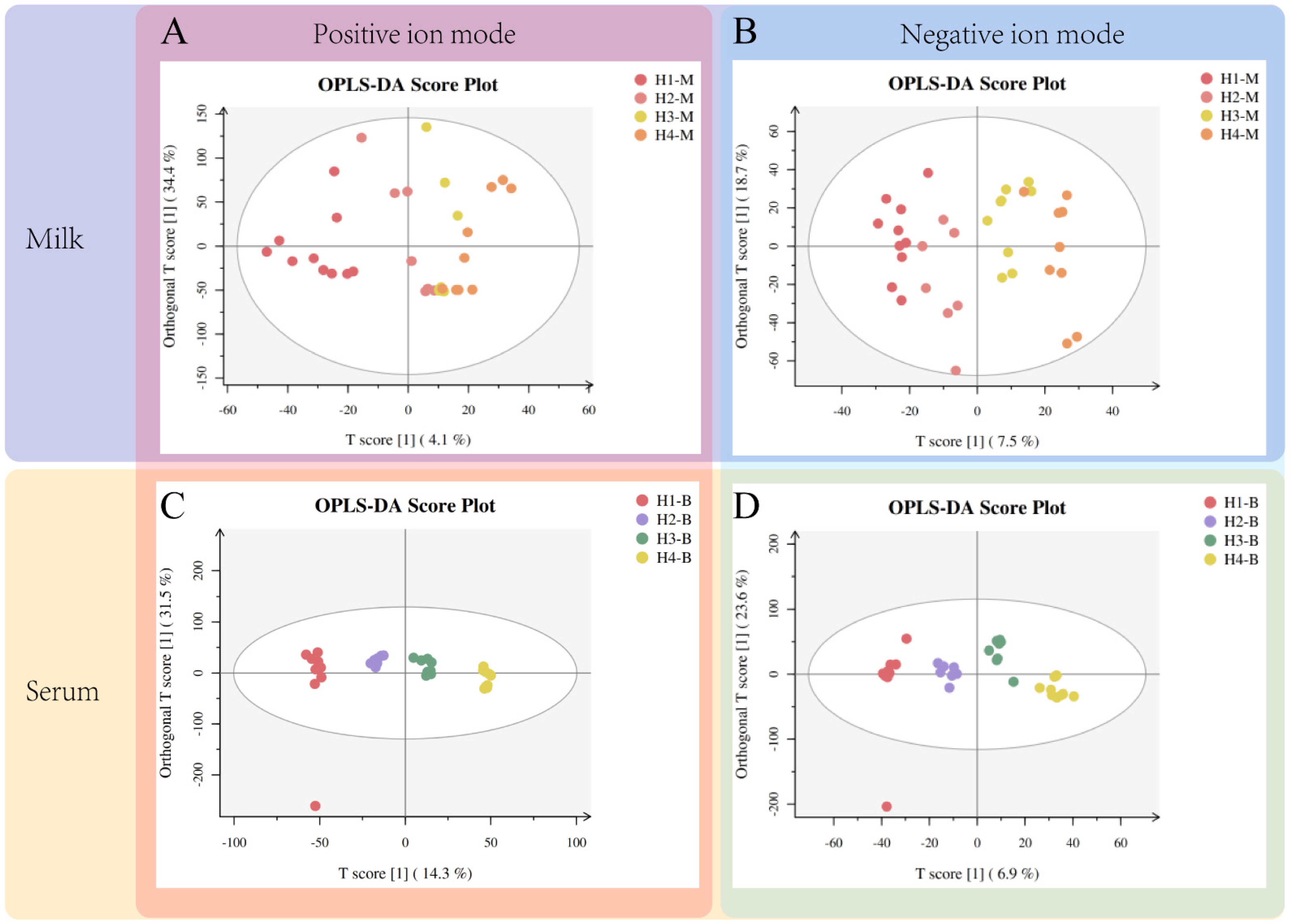
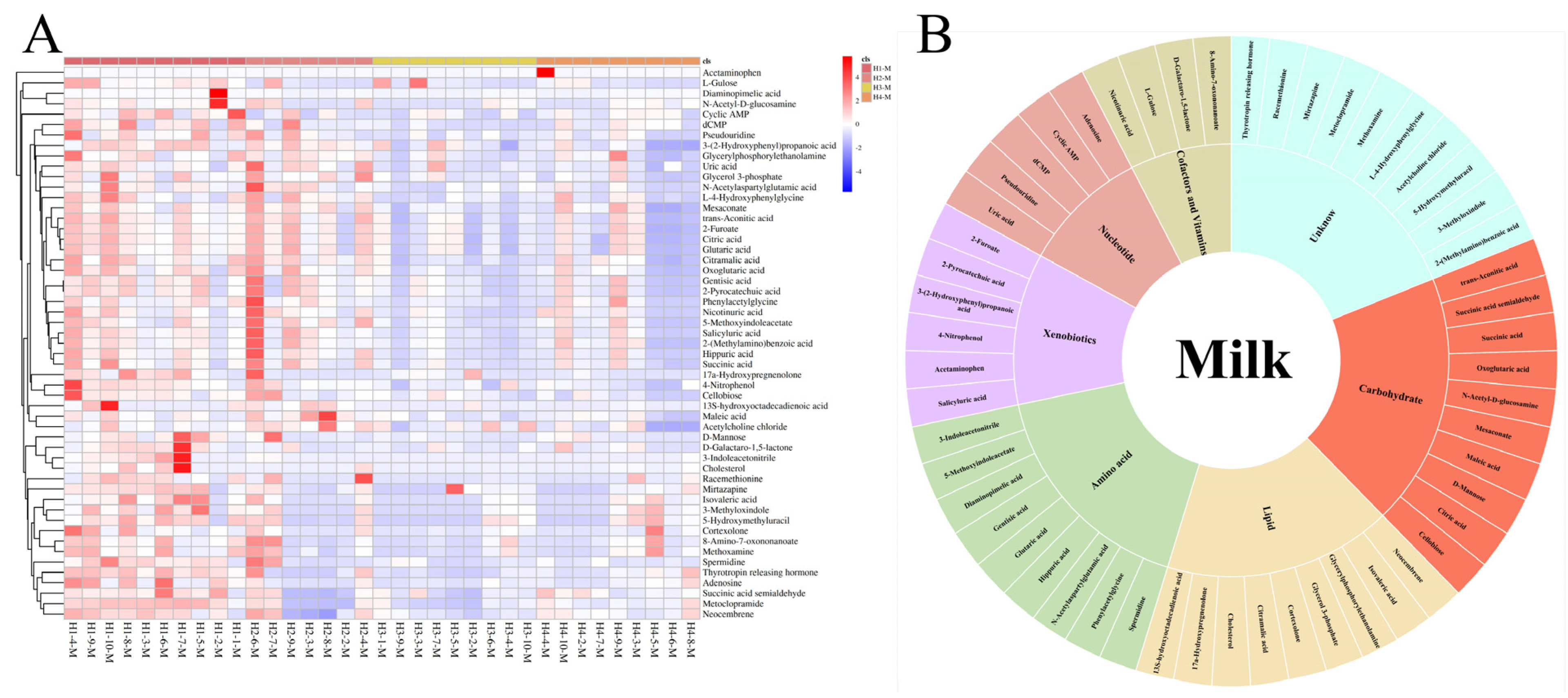
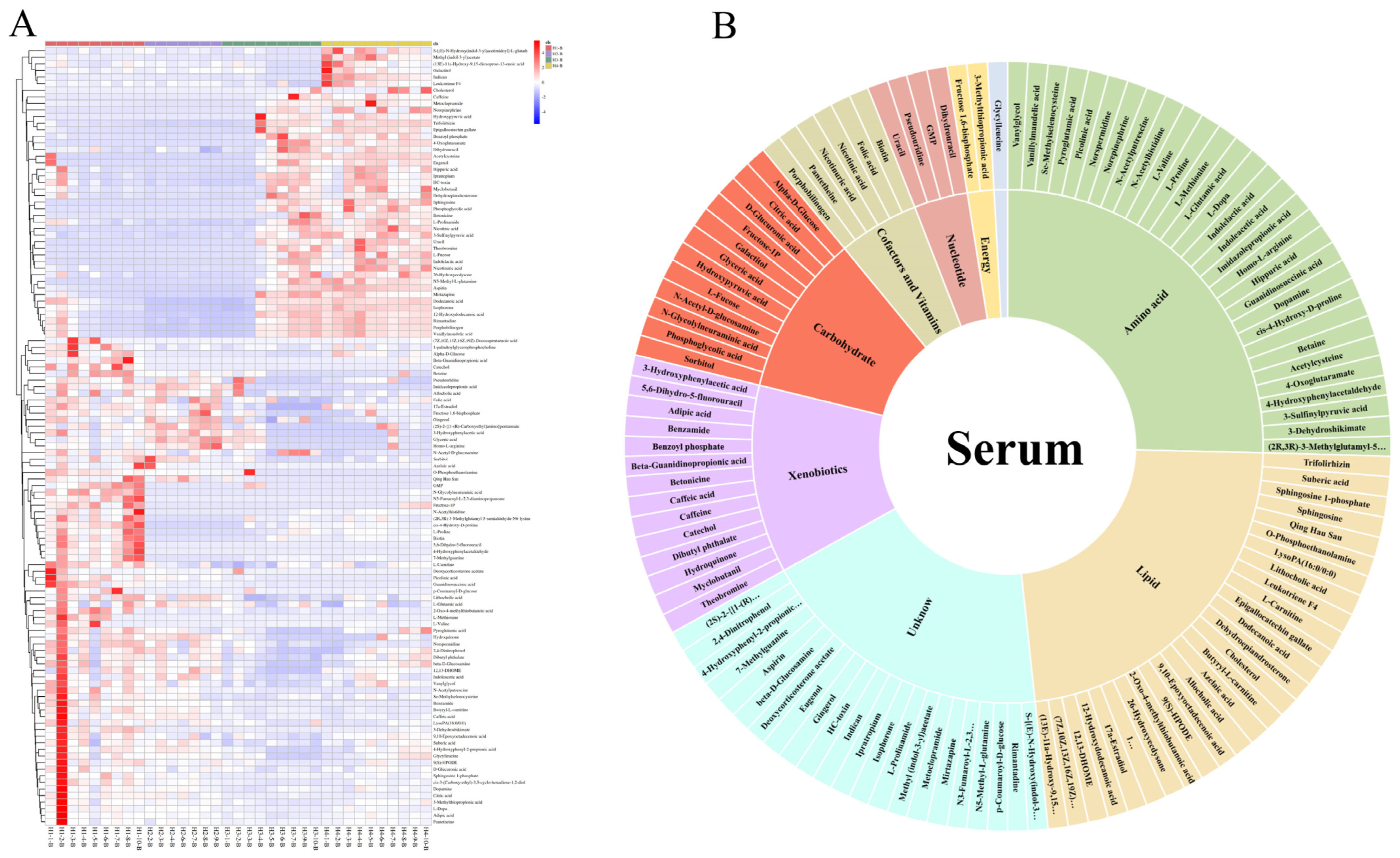
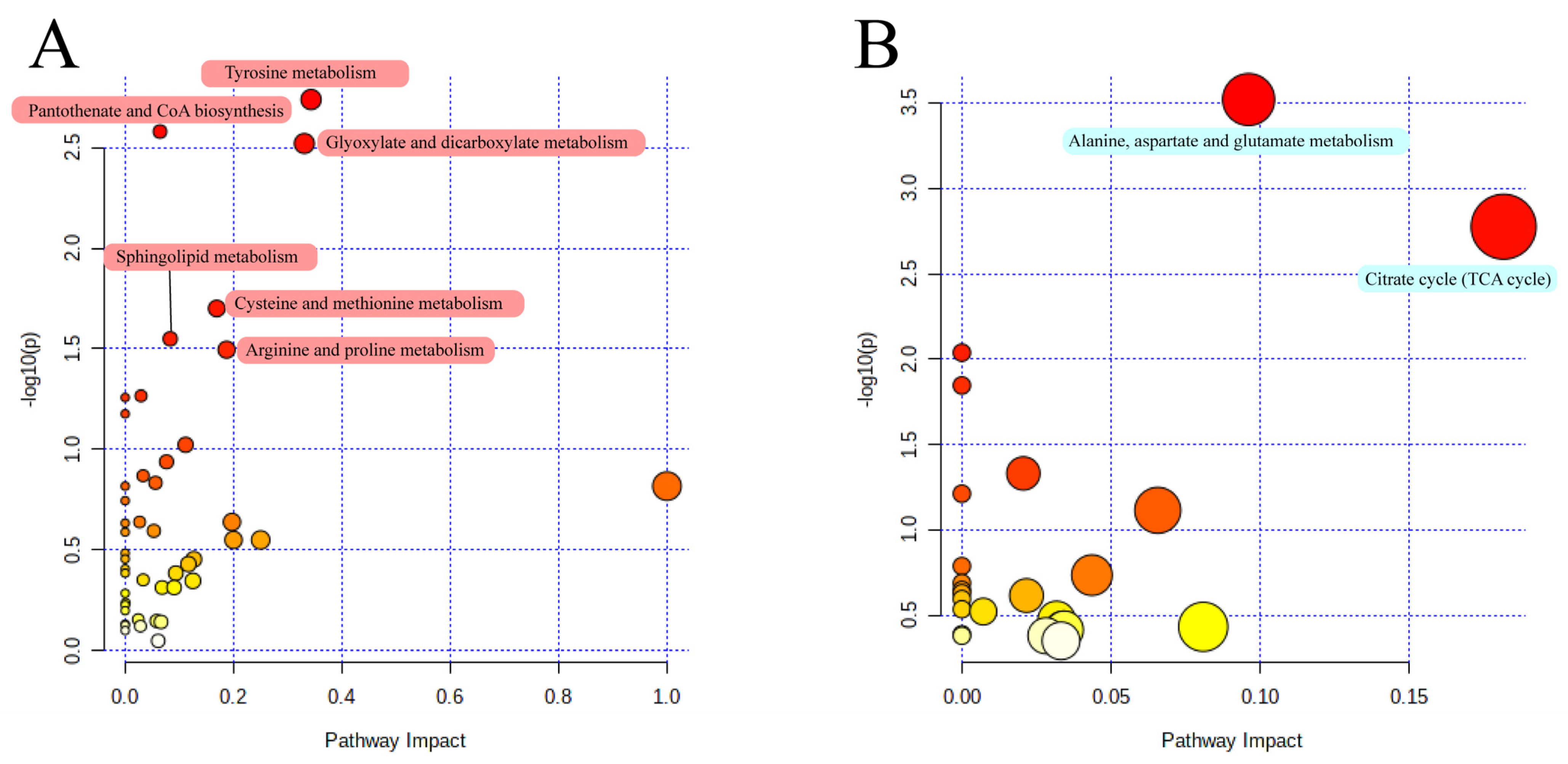

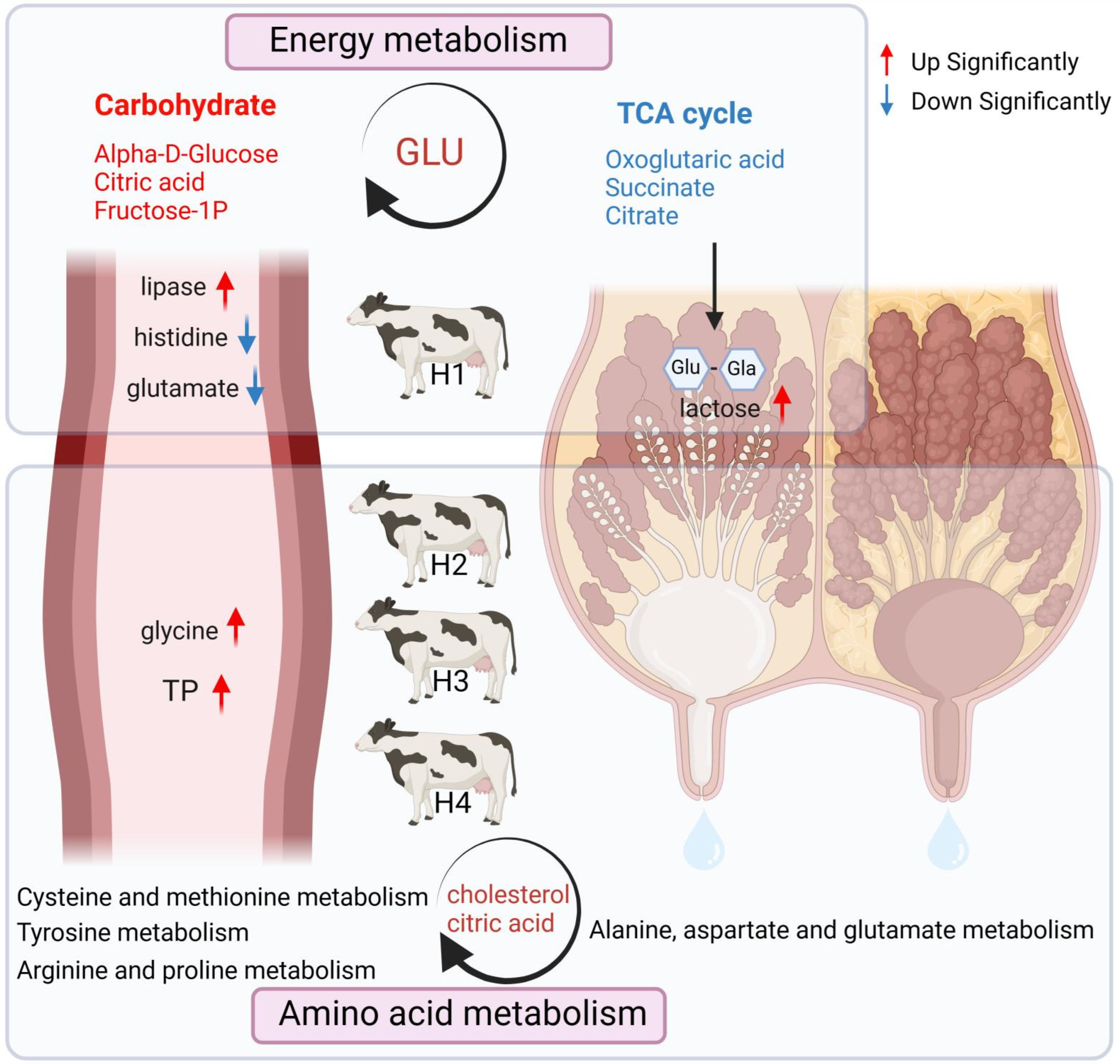
| Item 1 | Group 2 | SEM 3 | p-Value 4 | |||||
|---|---|---|---|---|---|---|---|---|
| H1 | H2 | H3 | H4 | T | L | Q | ||
| BW (kg) | 567 | 576 | 571 | 566 | 3.49 | 0.782 | 0.755 | 0.334 |
| DMI (kg/d) | 22.62 | 23.14 | 23.76 | 23.19 | 0.21 | 0.248 | 0.052 | 0.927 |
| Milk yield (kg/d) | 31.63 | 27.91 | 33.01 | 29.79 | 1.21 | 0.533 | 0.968 | 0.921 |
| Somatic cell count (×1000 cells/mL) | 24.5 | 42.25 | 29.43 | 35.83 | 4.36 | 0.574 | 0.589 | 0.551 |
| Milk fat (%) | 4.15 | 4.26 | 4.24 | 4.25 | 0.19 | 0.997 | 0.888 | 0.906 |
| Milk protein (%) | 4.13 | 4.17 | 4.00 | 4.11 | 0.07 | 0.887 | 0.741 | 0.806 |
| Lactose (%) | 5.19 a | 4.97 b | 4.94 b | 5.09 ab | 0.04 | 0.036 | 0.253 | 0.009 |
| Dry matter without fat (%) | 9.50 | 9.30 | 9.11 | 9.36 | 0.07 | 0.221 | 0.301 | 0.107 |
| Urea Nitrogen (%) | 11.59 | 12.63 | 12.44 | 11.86 | 0.17 | 0.117 | 0.663 | 0.021 |
| Item | Group 1 | SEM 2 | p-Value 3 | |||||
|---|---|---|---|---|---|---|---|---|
| H1 | H2 | H3 | H4 | T | L | Q | ||
| Glucose (mM) | 3.41 | 3.56 | 3.69 | 3.91 | 0.07 | 0.081 | 0.012 | 0.807 |
| Total protein (g/L) | 82.60 b | 82.06 b | 87.00 ab | 91.78 a | 1.28 | 0.013 | 0.002 | 0.252 |
| Albumin (g/L) | 41.22 | 39.5 | 42.39 | 41.81 | 0.64 | 0.481 | 0.408 | 0.663 |
| Blood urea nitrogen (mM) | 5.73 | 5.89 | 6.14 | 5.96 | 0.19 | 0.909 | 0.585 | 0.677 |
| Triglyceride (mM) | 0.13 | 0.15 | 0.13 | 0.12 | 0.01 | 0.172 | 0.206 | 0.099 |
| Low-density lipoprotein (mM) | 2.77 | 2.65 | 2.61 | 2.59 | 0.13 | 0.965 | 0.634 | 0.853 |
| High-density lipoprotein (mM) | 3.95 | 3.77 | 3.95 | 3.79 | 0.10 | 0.884 | 0.749 | 0.963 |
| Lipase (U/L) | 17.11 b | 20.20 a | 20.03 a | 19.93 a | 0.41 | 0.022 | 0.291 | 0.083 |
| Serum ammonia (μM) | 270.68 | 259.39 | 272.00 | 265.82 | 5.28 | 0.859 | 0.967 | 0.817 |
| Item 1 | Group 2 | SEM 3 | p-Value 4 | |||||
|---|---|---|---|---|---|---|---|---|
| H1 | H2 | H3 | H4 | T | L | Q | ||
| EAAs | 115.64 | 126.96 | 126.50 | 120.44 | 2.99 | 0.495 | 0.598 | 0.164 |
| Threonine | 25.81 | 25.89 | 25.06 | 24.36 | 0.48 | 0.658 | 0.230 | 0.692 |
| Valine | 26.80 | 29.22 | 29.88 | 28.72 | 0.91 | 0.650 | 0.431 | 0.346 |
| Methionine | 3.83 | 3.28 | 3.45 | 3.89 | 0.20 | 0.702 | 0.857 | 0.246 |
| Isoleucine | 12.87 | 14.19 | 13.25 | 12.72 | 0.43 | 0.681 | 0.713 | 0.300 |
| Leucine | 16.33 | 18.69 | 19.01 | 17.18 | 0.65 | 0.413 | 0.613 | 0.120 |
| Phenylalanine | 7.52 | 7.32 | 7.81 | 6.98 | 0.19 | 0.522 | 0.528 | 0.449 |
| Lysine | 14.22 | 18.54 | 16.88 | 16.49 | 0.57 | 0.055 | 0.267 | 0.034 |
| Histidine | 8.26 c | 9.81 b | 11.16 a | 10.09 b | 0.23 | <0.001 | <0.001 | <0.001 |
| NEAAs | 133.92 | 130.61 | 143.88 | 142.70 | 2.88 | 0.310 | 0.119 | 0.854 |
| Aspartate | 2.19 | 2.12 | 2.20 | 2.19 | 0.08 | 0.989 | 0.913 | 0.853 |
| Serine | 9.53 | 9.63 | 10.81 | 11.24 | 0.29 | 0.075 | 0.011 | 0.767 |
| Glutamate | 24.76 b | 24.74 ab | 30.56 a | 25.85 ab | 0.86 | 0.039 | 0.193 | 0.149 |
| Glycine | 26.09 ab | 21.65 b | 27.33 ab | 29.65 a | 0.95 | 0.031 | 0.036 | 0.060 |
| Alanine | 23.68 | 23.28 | 22.87 | 23.99 | 0.52 | 0.885 | 0.912 | 0.484 |
| Cysteine | 3.06 | 2.73 | 2.66 | 2.90 | 0.12 | 0.641 | 0.606 | 0.257 |
| Tyrosine | 7.69 | 8.26 | 7.66 | 7.43 | 0.31 | 0.844 | 0.619 | 0.532 |
| Arginine | 25.63 | 25.29 | 28.73 | 29.36 | 0.85 | 0.220 | 0.051 | 0.774 |
| Proline | 11.29 | 12.90 | 11.06 | 10.08 | 0.57 | 0.438 | 0.277 | 0.269 |
| TAAs | 249.56 | 257.57 | 270.38 | 263.14 | 5.30 | 0.545 | 0.259 | 0.487 |
| EAA/TAA | 0.46 | 0.49 | 0.47 | 0.46 | 0.00 | 0.065 | 0.336 | 0.027 |
Disclaimer/Publisher’s Note: The statements, opinions and data contained in all publications are solely those of the individual author(s) and contributor(s) and not of MDPI and/or the editor(s). MDPI and/or the editor(s) disclaim responsibility for any injury to people or property resulting from any ideas, methods, instructions or products referred to in the content. |
© 2024 by the authors. Licensee MDPI, Basel, Switzerland. This article is an open access article distributed under the terms and conditions of the Creative Commons Attribution (CC BY) license (https://creativecommons.org/licenses/by/4.0/).
Share and Cite
Liu, Z.; Jiang, A.; Lv, X.; Zhou, C.; Tan, Z. Metabolic Changes in Serum and Milk of Holstein Cows in Their First to Fourth Parity Revealed by Biochemical Analysis and Untargeted Metabolomics. Animals 2024, 14, 407. https://doi.org/10.3390/ani14030407
Liu Z, Jiang A, Lv X, Zhou C, Tan Z. Metabolic Changes in Serum and Milk of Holstein Cows in Their First to Fourth Parity Revealed by Biochemical Analysis and Untargeted Metabolomics. Animals. 2024; 14(3):407. https://doi.org/10.3390/ani14030407
Chicago/Turabian StyleLiu, Zixin, Aoyu Jiang, Xiaokang Lv, Chuanshe Zhou, and Zhiliang Tan. 2024. "Metabolic Changes in Serum and Milk of Holstein Cows in Their First to Fourth Parity Revealed by Biochemical Analysis and Untargeted Metabolomics" Animals 14, no. 3: 407. https://doi.org/10.3390/ani14030407
APA StyleLiu, Z., Jiang, A., Lv, X., Zhou, C., & Tan, Z. (2024). Metabolic Changes in Serum and Milk of Holstein Cows in Their First to Fourth Parity Revealed by Biochemical Analysis and Untargeted Metabolomics. Animals, 14(3), 407. https://doi.org/10.3390/ani14030407





